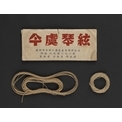
- Jinyu Strings, product of Suzhou Cooperative for the production of Carvings (produced after 1954) (1)
Traditionally, qin strings had been made in family workshops. After 1949, private enterprises became under joint state-private ownership. In September 1954, Fang Yuting’s workshop joined the Suzhou Cooperative for the Production of Carvings. He continued to make strings to meet the needs of qin players all over the country.
Except for the name of the manufacturer, the wrapping of the strings was the same as that originally used by Fang Yuting, including the process of string making described by Wu Jinglue in 1944 printed on the back of the wrapping. Another string maker was He Zhengqi, a student of Fang Yuting. He was Fang Yuting’s only student who was named on product wrappings.
This exhibit is in paper wrapping. The spare string is missing. The method of tying the strings is the same as that used by Laosantai Huihui Tang of the late Qing Dynasty.
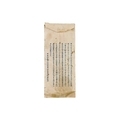
- Jinyu Strings, product of Suzhou Cooperative for the production of Carvings (produced after 1954) (2)
This photo shows the back of the paper wrapping. Traditionally, qin strings had been made in family workshops. After 1949, private enterprises became under joint state-private ownership. In September 1954, Fang Yuting’s workshop joined the Suzhou Cooperative for the Production of Carvings. He continued to make strings to meet the needs of qin players all over the country.
Except for the name of the manufacturer, the wrapping of the strings was the same as that originally used by Fang Yuting, including the process of string making described by Wu Jinglue in 1944 printed on the back of the wrapping. Another string maker was He Zhengqi, a student of Fang Yuting. He was Fang Yuting’s only student who was named on product wrappings.
This exhibit is in paper wrapping. The spare string is missing. The method of tying the strings is the same as that used by Laosantai Huihui Tang of the late Qing Dynasty.
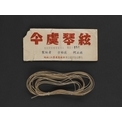
- Jinyu Strings, product of Suzhou National Musical Instrument Factory (produced in the late 1950s) (1)
In the late 1950s, the string making unit of the Suzhou Cooperative for the Production of Carvings was incorporated into the Suzhou National Musical Instrument Factory and continued to produce qin strings. The strings were packed in paper wrappings as in the past. Everything remained the same, except the name of the manufacturer and its address and telephone number.
In this exhibit, only a bundle of the first to the fourth strings remains. The fifth to the seventh strings and the spare string are missing.
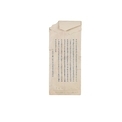
- Jinyu Strings, product of Suzhou National Musical Instrument Factory (produced in the late 1950s) (2)
This photo shows the back of paper wrapping. In the late 1950s, the string making unit of the Suzhou Cooperative for the Production of Carvings was incorporated into the Suzhou National Musical Instrument Factory and continued to produce qin strings. The strings were packed in paper wrappings as in the past. Everything remained the same, except the name of the manufacturer and its address and telephone number.
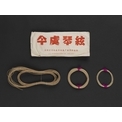
- Jinyu Strings, product of Suzhou Fang Yuting Cooperative for the Production of Strings (produced in 1964)
In 1962, the production of strings was again separated and became the “Suzhou Fang Yuting Cooperative for the Production of Strings”. This was the height of Fang Yuting’s career.
The exhibit is one of the 100 sets of strings ordered by the Beijing Guqin Society in 1964. Paper wrapping is used. The first to fourth strings are tied with the end of the strings, while the fifth to seventh strings and the spare string are tied with red threads.
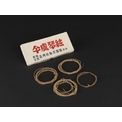
- Jinyu Strings, product of local state-owned Suzhou National Musical Instrument Factory (produced in the lat...
In late 1960s, Suzhou Fang Yuting Cooperative for the Production of Strings was again merged with the local state-owned Suzhou National Musical Instrument Factory. It became a silk string production unit of the Factory and continued to produce Jinyu Strings.
The exhibit is packed in a paper box. The strings have been used. Only the first to the fourth strings remain. The strings are incomplete.
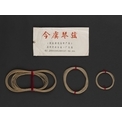
- Jinyu Strings, product of Suzhou No.1 National Musical Instrument Factory (produced in the 1970s)
In the 1970s, the local state-owned Suzhou No.1 National Musical Instrument Factory was renamed the Suzhou National Musical Instrument Factory. The Jinyu Strings produced was in paper wrapping. However, the characters for the name “Jinyu Strings” were not in the same font type as that used in the past but were in a style written with a brush.
In this exhibit, the first to the fourth strings are still tied with the end of the strings, reinforced with a red thread; the fifth to the seventh strings and the spare string are tied together with red threads.
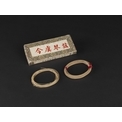
- Jinyu Strings, product of Suzhou No.1 National Musical Instrument Factory
(produced in the 1980s)
The quality of Jinyu Strings deteriorated markedly in the 1970s and 1980s. The prints cut out from old wrappings were pasted on the inside and outside of the paper box used in the 1980s.
The spare string is missing in the exhibit. The thread used to tie the fifth to seventh strings has been lost. The method of tying the first to fourth strings has also changed to the use of red threads.
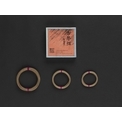
- Guqin Strings, product of Suzhou No.1 National Musical Instrument Factory
In the 1990s, the quality of qin strings was the poorest. The Suzhou National Musical Instrument Factory had abandoned the Jinyu String brand. The package was changed into a small paper box labelled with the characters gu qin xian (guqin strings). “Jinyu Strings” was included on the lower left hand corner of the box as a small label. On top of the name of the manufacturer, the trademark of the “Huqiu” brand was included.
All the strings of this exhibit are tied with red threads and were produced after the 1990s.
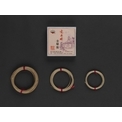
- Huqiu Strings, product of Suzhou No.1 National Musical Instrument Factory Limited
After the year 2000, Suzhou No.1 National Musical Instrument Factory changed to a contract system and was renamed Suzhou No.1 National Musical Instrument Factory Company Limited. The qin strings produced were formally named “Huqiu Guqin Strings”. This put an end to the history of Jinyu Strings. This photo shows “Huqiu Guqin Strings” produced after the 2000s.
